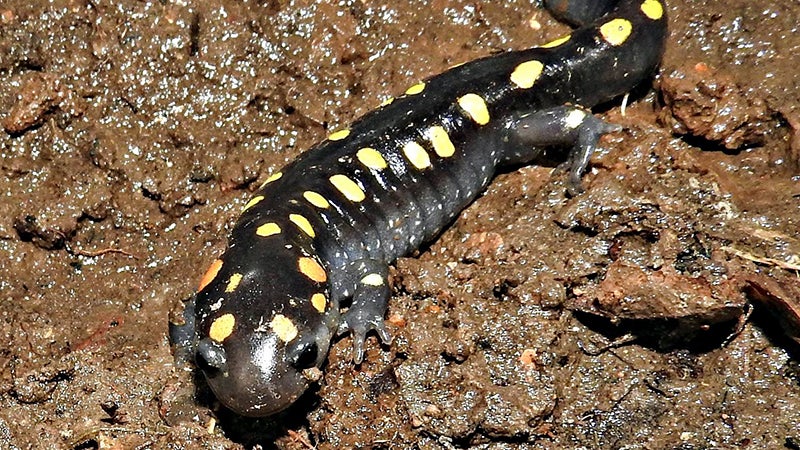Have you seen Spotted Salamander in Polk County?
Published 5:22 pm Wednesday, January 30, 2019

- Spotted Salamander (Ambystoma maculatum)
This month’s Polk County’s Most Wanted challenge is one of our most spectacular amphibians, the Spotted Salamander (Ambystoma maculatum). This is the time of year when you just might see them, if you know where and when to look.
Belonging to the Mole Salamander family (an allusion to this group’s habit of digging), the Spotted Salamander is native to eastern North America, from southern Canada to eastern Texas. A stout species reaching up to nine inches in length with a black body covered in bright yellow “polka dots,” the Spotted Salamander is impossible to confuse with any other species throughout its range. Their diet consists of insects and other invertebrates.
Their preferred habitats are moist deciduous woodlands, although they may occasionally be found in other, drier habitats where they can get well below ground under rocks, logs, and other debris. Spotted Salamanders are rarely encountered outside of their breeding season of late winter to very early spring, dwelling as they do in underground burrows.
The best time to observe this species is when they aggregate in numbers at their breeding sites which are typically temporary vernal pools in woodlands. The salamanders prefer these pools for breeding, as they are fish-free and thus less risky for their offspring to develop in. Male Spotted Salamanders generally reach the pools first and deposit white packets of sperm on the leaf-covered bottoms of the pools. These packets are known as spermatophores and they are visible during daylight hours, even when the salamanders are not—a valuable clue to their presence.
Actual ‘mating’ takes place at night as female Spotted Salamanders pick up the spermatophores to induce fertilization of their eggs. At such times one may be fortunate enough to see many hundreds of Salamanders cavorting in total silence underwater, an incredible spectacle. In time, large gelatinous egg masses will be visible in these pools, from which larval salamanders will hatch and complete their transformation from aquatic to terrestrial organisms within a matter of weeks. Juveniles are more slender than adults and have fewer, less prominent spots.
Although they are not rare in North Carolina, it would be valuable to know more about the range of Spotted Salamanders in our state and throughout Polk County. With the onset of warm rains in late winter and early spring (coming soon!), these salamanders will be leaving their underground hibernation spots to journey to their breeding ponds. Scout out any vernal pools in your area and venture out on a rainy night with some friends and a few flashlights, you just may be rewarded with witnessing the ancient and mysterious rite of spring performed by this beautiful and gentle denizen of our forests.
If you think that you have seen Spotted Salamanders in Polk County, or if you locate them in the coming weeks, please send photos, questions, comments to Pam Torlina at Conserving Carolina by phone at (828)697-5777, ext. 300 or email, pam@conservingcarolina.org, so we can document its occurrence in Polk County.
Visit Conserving Carolina’s website, conservingcarolina.org/polk-most-wanted, for more information about “Polk County’s Most Wanted” and to download and print a “Pocket Guide” with all of the “Most Wanted” plants, animals, and habitats that you can be on the lookout for!
Conserving Carolina, your local land trust, is dedicated to protecting land and water, promoting good stewardship, and creating opportunities for people to enjoy nature. Learn more and become a member at conservingcarolina.org.
– Submitted by David Campbell





